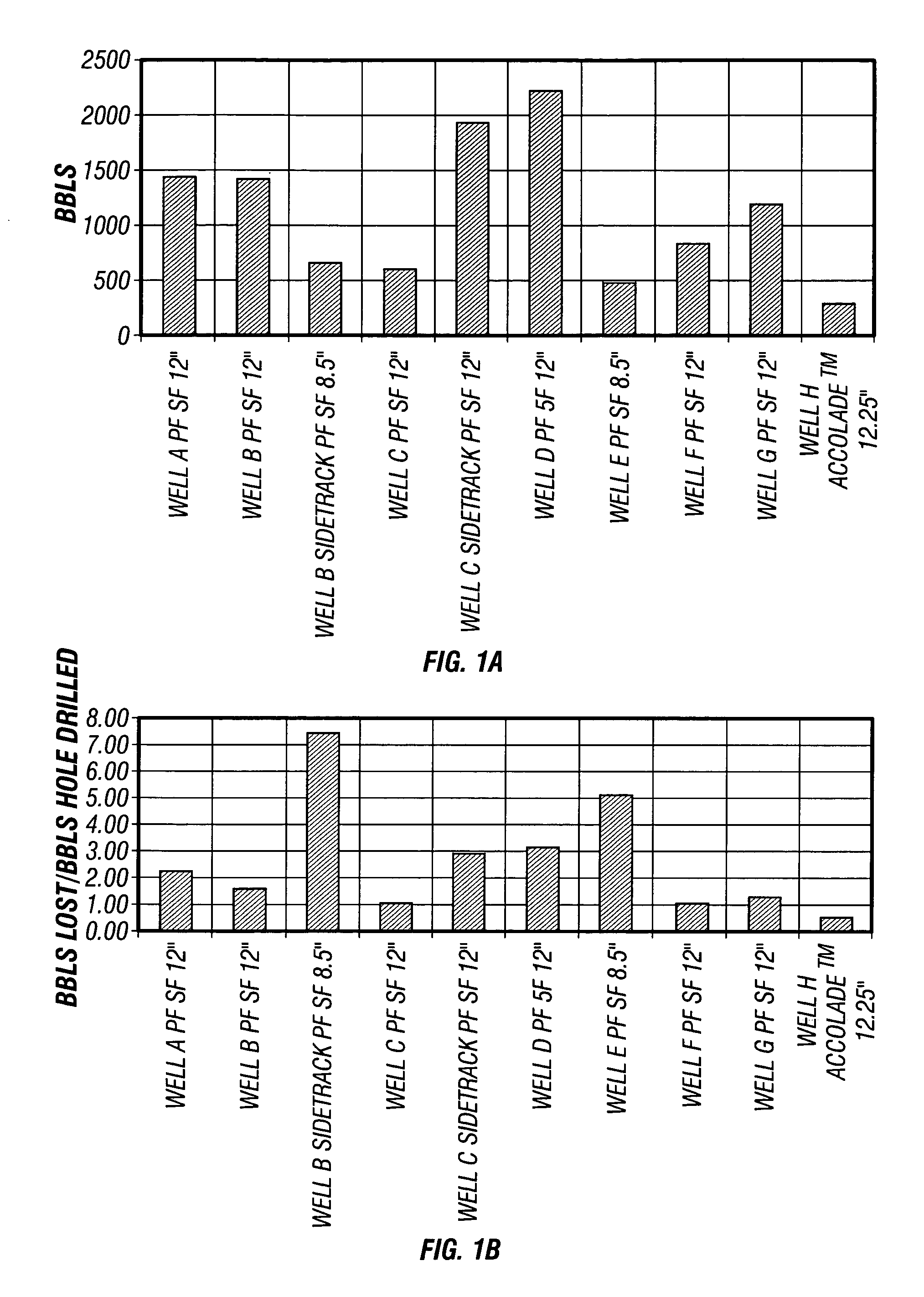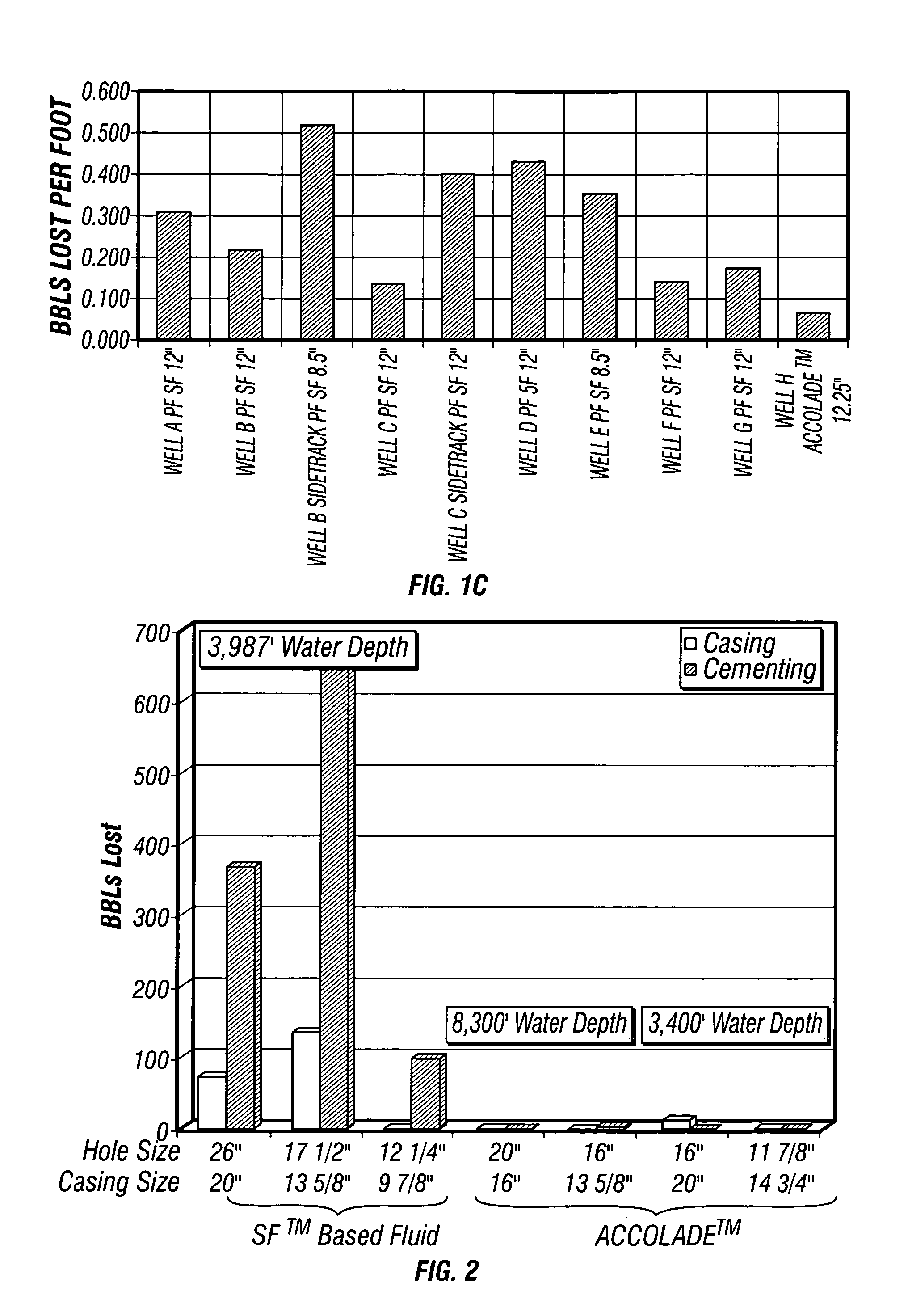The present invention provides a fluid and a method for drilling boreholes or wellbores in subterranean formations with reduced loss of drilling fluids or muds into the formation. This
advantage of the invention is effected by formulating, providing or using a drilling fluid that forms a “fragile gel.” A “gel” may be defined a number of ways. One definition indicates that a “gel” is a generally colloidal suspension or a mixture of microscopic water particles (and any hydrophilic additives) approximately uniformly dispersed through the oil (and any hydrophobic additives), such that the fluid or gel has a generally homogeneous gelatinous consistency. Another definition states that a “gel” is a
colloid in a more
solid form than a “
sol” and defines a “
sol” as a fluid colloidal
system, especially one in which the continuous phase is a liquid. Still another definition provides that a “gel” is a
colloid in which the disperse phase has combined with the continuous phase to produce a viscous jelly-like product. A gel has a structure that is continually building. If the yield stress of a fluid increases over time, the fluid has gels. Yield stress is the stress required to be exerted to initiate deformation.
is effected by formulating, providing or using a drilling fluid that forms a “fragile gel.” A “gel” may be defined a number of ways. One definition indicates that a “gel” is a generally colloidal suspension or a mixture of microscopic water particles (and any hydrophilic additives) approximately uniformly dispersed through the oil (and any hydrophobic additives), such that the fluid or gel has a generally homogeneous gelatinous consistency. Another definition states that a “gel” is a
colloid in a more
solid form than a “
sol” and defines a “sol” as a fluid colloidal
system, especially one in which the continuous phase is a liquid. Still another definition provides that a “gel” is a colloid in which the disperse phase has combined with the continuous phase to produce a viscous jelly-like product. A gel has a structure that is continually building. If the yield stress of a fluid increases over time, the fluid has gels. Yield stress is the stress required to be exerted to initiate deformation.
A “fragile gel” as used herein is a “gel” that is easily disrupted or thinned, and that liquifies or becomes less gel-like and more liquid-like under stress, such as caused by moving the fluid, but which quickly returns to a gel when the movement or other stress is alleviated or removed, such as when circulation of the fluid is stopped, as for example when drilling is stopped. The “fragileness” of the “fragile gels” of the present invention contributes to the unique and surprising behavior and advantages of the present invention. The gels are so “fragile” that it is believed that they may be disrupted by a mere
pressure wave or a compression wave during drilling. They seem to break instantaneously when disturbed, reversing from a gel back into a liquid form with minimum pressure, force and time and with less pressure, force and time than known to be required to convert prior art fluids from a gel-like state into a flowable state.
When drilling is stopped while using a drilling fluid of the present invention, and consequently the stresses or forces associated with drilling are substantially reduced or removed, the drilling fluid forms a gel structure that allows it to suspend
drill cuttings and weighting materials for delivery to the well surface. The drilling fluid of the invention suspends
drill cuttings through its gel or gel-like characteristics, without need for organophilic clays to add
viscosity to the fluid. As a result, sag problems do not occur. Nevertheless, when drilling is resumed, the fragile gel is so easily and instantly converted back into a liquid or flowable state that no initial appreciable or noticeable pressure spike is observed with pressure-while-drilling (PWD) equipment or instruments. In contrast, such pressure spikes are commonly or normally seen when using prior art fluids.
Further, the drilling fluid of the invention generally maintains consistently low values for the difference in its surface density and its equivalent density downhole during drilling operations notwithstanding variations in the rate of drilling or penetration into the subterranean formation and notwithstanding other downhole stresses on the fluid. The fragile gels of the invention may be visco-elastic, contributing to their unique behavior and to the advantages of the invention.
The drilling fluid of the invention responds quickly to the addition of thinners, with
thinning of the fluid occurring soon after the thinners are added, without need for multiple circulations of the fluid with the thinners additive or additives in the wellbore to show the effect of the addition of the thinners. The drilling fluid of the invention also yields flatter profiles between cold water and downhole rheologies, making the fluid advantageous for use in
deep water wells. That is, the fluid may be thinned at cold temperatures without causing the fluid to be comparably thinned at higher temperatures. As used herein, the terms “
deep water” with respect to wells and “higher” and “lower” with respect to temperature are relative terms understood by one skilled in the art of the oil and
gas industry. However, generally, as used herein, “deep water wells” refers to any wells at water depths greater than about 1500 feet deep, “higher temperatures” means temperatures over about 120 degrees Fahrenheit and “lower temperatures” means temperatures at about 40 to about 60 degrees Fahrenheit.
Rheology of a drilling fluid is typically measured at about 120 or about 150 degrees Fahrenheit.
 Login to View More
Login to View More 


